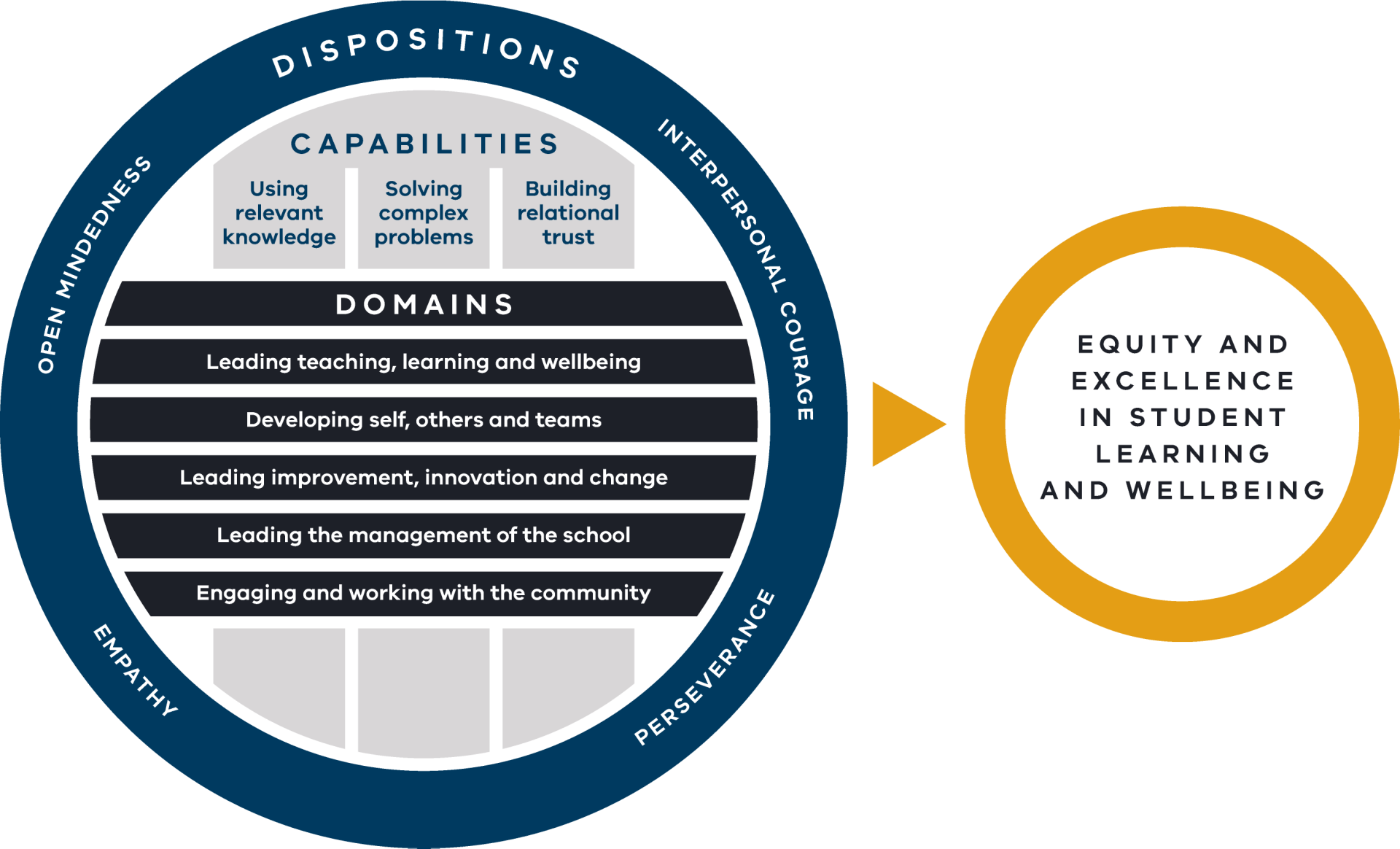Academy Leadership Excellence Framework
Elevating school leadership
There's compelling evidence that effective school leadership has a critical impact on student learning, well-being, and achievement. The Victorian Academy of Teaching and Leadership developed the Academy Leadership Excellence Framework (ALEF) to inspire and guide current and future school leaders toward excellence. Investing in leaders is essential to ensuring every child gets the best start in life and the chance to reach their full potential.
Excellent educational leadership involves integrating a small number of key capabilities across multiple domains of practice motivated by the right dispositions. The ALEF is a comprehensive guide to what it takes to be a great school leader.

What is the Academy Leadership Excellence Framework (ALEF)?
The Academy Leadership Excellence Framework (ALEF) is a guide for developing leadership skills in schools. It sets out the practices, capabilities, and dispositions required for excellence at all levels of leadership, from classroom teachers to principals. The framework equips school leaders with the skills and mindset to make student-centred decisions and drive positive change within their schools.
Key components of the ALEF
The ALEF is built upon three key components: domains, capabilities, and dispositions. Understanding these elements is crucial for anyone looking to develop their educational leadership skills.
Domains
The ALEF outlines five domains of practice for effective school leadership:
- Leading teaching, learning, and wellbeing: Fostering an environment that promotes high-quality instruction and student well-being
- Developing self, others, and teams: Cultivating personal growth and building the capacity of colleagues and teams
- Leading improvement, innovation, and change: Driving positive change and adapting to new challenges within the school environment
- Leading the management of the school: Effectively managing school operations and resources
- Engaging and working with the community: Building strong relationships with parents, carers, and the wider community to support student success
Leadership capabilities
The ALEF identifies three essential leadership capabilities:
- Using relevant knowledge: Applying evidence-based research and expertise to school situations
- Solving complex problems: Navigating difficult challenges with strategic thinking and sound judgment
- Building trust: Fostering strong, reliable relationships with students, staff, and the community
Dispositions
Dispositions are the motivations and emotions that drive a leader's behaviour. The ALEF highlights four critical dispositions for educational leadership excellence:
- Open-mindedness: Being receptive to new ideas and perspectives
- Interpersonal courage: Having the strength to have difficult conversations and make tough decisions
- Empathy: Understanding and sharing the feelings of others
- Perserverance: Staying committed to long-term goals despite challenges
The Framework in practice
The ALEF is a practical tool for school leader development at every career stage. It can be used by individuals, leadership teams, or professional networks to assess and develop the skills of current and aspiring leaders. It helps leaders make informed, student-centred decisions by integrating the right practices, capabilities, and dispositions for any given situation.
Excellent leadership isn't just for those in formal positions; it's something everyone can aspire to. Principals, assistant principals, middle leaders, emerging leaders and classroom teachers can all use the ALEF to develop leadership excellence. The Academy is committed to supporting this development to ensure that highly committed and skilled leaders are advancing educational excellence across the system.
Development and resources
The ALEF was developed over several years by reviewing research and consulting with Victorian school and system leaders. It draws on the extensive work of Distinguished Professor Viviane Robinson of the University of Auckland, a renowned expert in school improvement and leadership.
Video resource
To learn more about the framework, watch the introductory video below and download the video transcript, featuring Kate Morris and Professor Viviane Robinson.
Download resource
You can also download the full Academy Leadership Excellence Framework and explore related learning activities designed to deepen your understanding.

Download


Download

Learn more about the ALEF
Discover
- Discover our range of ALEF resources for your school and school leaders
- Explore the ALEF sections in more detail:
Learning activities
Engage in our learning activities to help you and your team apply the ALEF
Reading activity 1: Connect - Extend - Challenge
A routine for individuals to draw connections between new ideas and prior knowledge.
Adapted from Project Zero, Harvard Graduate School of Education.
Purpose
This activity will help you make connections between new ideas and prior knowledge in relation to educational leadership excellence. It also encourages you to take note of ongoing questions, puzzles and difficulties as you reflect on what you are reading.
Time
This protocol can take as long as you like. It is suggested that you take enough time to sit with your thoughts and reflections. Allow up to 30 minutes.
Process
As you read, individually record personal connections, extensions and challenges. Write your thoughts down and respond to the following questions.
- How do the ideas and information presented connect with what you already knew?
- What new ideas did you get that extended or broadened your thinking in new directions?
- What challenges or puzzles have come to mind from the ideas and information presented?
- How is the Framework connected to something you already know about? What new ideas or impressions do you have that extended your thinking in new directions? What is challenging or confusing? What do you wonder about.
Reading activity 2: The Four "A"s
A routine for pairs and teams to connect new knowledge with personal beliefs.
Adapted from Judith Gray, Seattle, Washington 2005.
Purpose
To explore a text deeply in relation to one’s own values and intentions.
Process
Five minutes total for each participant, plus 10 minutes for the final two steps.
- The group reads the Academy Leadership Excellence Framework (PDF) (Doc) silently, highlighting parts and writing notes in the margin or on sticky notes in answer to the following 4 questions (you can also add your own "A"s).
- What Assumptions does the author of the text hold?
- What do you Agree with in the text?
- What do you want to Argue with in the text?
- What parts of the text do you want to Aspire to (or Act upon)?
- In a round, have each person identify one assumption in the text, citing the text (with page numbers, if appropriate) as evidence.
- Either continue in rounds or facilitate a conversation in which the group talks about the text in light of each of the remaining "A"s, taking them one at a time. What do people want to agree with, argue with, and aspire to (or act upon) in the text? Try to move seamlessly from one "A" to the next, giving each "A" enough time for full exploration.
- End the session with an open discussion framed around a question such as: What does this mean for our work with students?
- Debrief the text experience.
Reading activity 3: Word - Phrase - Sentence
A routine for teams and groups to capture the essence of a text.
Adapted from Project Zero, Harvard Graduate School of Education
Purpose
This routine provides structure for a conversation. It can be used as both a discourse and as a thinking routine.
The power and promise of this routine lies in the discussion of why a particular word, a single phrase, and a sentence stood out for each individual in the group as a catalyst for discussion.
Time
The timing of this activity will depend on the group or team size. Allow 2 – 3 minutes for each group member to share their ideas with follow up discussion, in each round for the word, phrase, sentence. In the plenary activity, allow time for the group to gather collective ideas.
Process
- As an individual, review the Academy Leadership Excellence Framework (PDF) (Doc) and then select and record a:
- word that captured your attention or struck you as powerful
- phrase that moved, engaged or provoked you
- sentence that was meaningful to you, that you felt captures the core idea of the text.
- As a group, discuss and record your choices. If your team is large, break into groups of 4.
- Sharing and discussion should occur in rounds, so the discussion is structured:
- First participant shares a word and explains why they chose it, inviting others to comment and discuss.
- The words are recorded and then the next person shares, records, and discusses until everyone has their turn.
- The group then moves to share and discuss their phrases and finally on to their sentences.
- Looking at your group’s collective choices of words, phrases, and sentences, reflect on the conversation by identifying:
- What themes emerge?
- What implications or predictions can be drawn?
- Were there aspects of the text not captured in your choices?
Self-reflection activity
Excellent leaders skilfully integrate the right combination of capabilities and dispositions to make the best decision for a students.
Use the self-reflection activity to consider how you use the capabilities and dispositions of the ALEF in your leadership.
Download the Self-reflection activity below for further instructions.
Download the activities
Available as a PDF or Word fileDiscover more resources
Access essential resources for the Academy Leadership Excellence Framework (ALEF). Download fact sheets, playbooks, and guides for school leaders.







